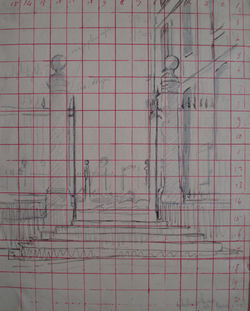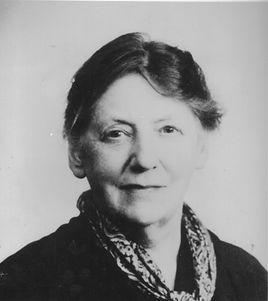Sylvia Gosse 1881-1968
I first bought a Sylvia Gosse drawing some thirty years ago. Alas I never met her, but I have had the privilege of meeting and knowing many of her friends. A niece of Sickert remembered her great kindness during her childhood in the 1920’s in Dieppe and at Envermeu, and appreciated the fact that they were both so shy. No doubt the formidable and somewhat peppery Sir Edmund Gosse contributed to this, but nevertheless, we are informed by Sylvia that she had a happy childhood. Marjorie Lilly tells of the novelist , Thomas Hardy, one of the many literary friends of her father, saying of Sylvia that “ I simply cannot get a word out of her”. Through her shyness Sylvia inhabited a very private world of flowers, plants, cats, and paint. After a private education at home and in France she reached the St. John’s Wood Art school, then the Royal academy schools, and at the age of twenty seven , Walter Richard Sickert. He not only stimulated her enthusiasm for art, he also stimulated in her an interest in his own domestic and financial well being which she carried on for over thirty years. Marjorie Lilly told me that with Sickert “…Sylvia Gosse and Therese Lessore came first , then probably his petit negres Wendela Boreel , Christiana Cutter and myself”. Wendela , who was a close friend until her death in 1985, and a long associate of Sickert’s , remembered that when the artist “…went to Dieppe , Sylvia was never far behind. You would see her pushing her bicycle down to Victoria Station to catch the boat-train”. Apart from the Sickert’s , Sylvia had few artist friends , although there were the Cliftons, Walter Taylor, Spencer Gore and Orovida Pissaro. Despite her modesty , however her life was full of good works. In conversation with her friends one only hears stories of devotion, kindness, and consideration. One story I particularly liked is the evening she caught a burglar in her house. Holding the wretched youth in a vice-like iron grip she led him to the door declaring “ …I am going to lead you out of my bungalow and don’t you ever come here again…”In later life she was once asked by an admirer to explain her work. She answered in her characteristically quiet and modest way “ Oh but it simply a question of light and shade …” – an answer of simplicity and honesty surely indicative of her life.
Michael Parkin
AVAILABLE SYLVIA GOSSE FOR SALE
 Le Château,DieppeEtching signed in plate Unframed £300 |  Sylvia GosseExhibition Catalogue 12 September to 20 October 1989 SCARCE £25.00 |  Regent StreetEtching signed SOLD |
|---|---|---|
 Dieppe GossipsSOLD |  Lighthouse, TreportSOLD |
Sylvia Gosse
It is virtually impossible to portray a personality, as Sylvia Gosse’s seems to have been in a few short sentences. Even intimate friends describe her as “a living contradiction”, and Thomas Hardy, a friend of her father Edmund Gosse, was frankly puzzled “ I’ve known Sylvia since she was a little girl, when I used to go up to the nursery and say goodnight to her in her cot, but I simply can’t get a word out of her these days”. (M. Lilly Sickert p.149)
Her shyness towards the outside world may have its roots in her extremely stern upbringing and the fact that at an early age she met and was overawed by the imposing personalities who came into her parent’s house every Sunday. Edmund Gosse , a prominent critic poet and essayist, and later librarian to the house of Lords, liked to gather round him some of the most celebrated literary figures of his time, such as Henry James, Hardy, Swinburne, Browning, and Walter Pater. The girl was educated privately at home and in the French town of Dinan, where she first became seriously absorbed in painting through the influence of an Art Master who taught her drawing and still life.
On her return to France, she then enrolled at St. John’s School of Art, where she stayed until her work was approved by the Royal Academy Schools. After a thorough three year training at the Royal Academy, each month under a different teacher, she left, technically competent, but without having made up her mind which direction to take. This state of indecision was prolonged by the reluctance of her father to countenance his daughter setting up as an independent, unmarried painter, although his wife-a pupil of Ford Madox Brown-had been a painter and his sister-in –law was married to Sir Alma Tadema. However a decisive encounter brought an end to this situation. Around 1908 Sickert, who was friendly with Edmund Gosse, became acquainted with Sylvia and apart from taking an immediate interest in her as a person, was impressed by the quality of her work. The encounter with Sickert stimulated her innate vitality and enthusiasm and seems to have provided her with the impetus to branch out on an independent artistic life, even if this meant that for several years to come she was often hard up and forced to sell her paintings to dealers for £1 a piece, fresh from the easel and often still damp.
This seems to have sparked off an extremely active life. In 1909 she showed three works at the second Allied Artists Association exhibition. In the same year, encouraged by Sickert , she became interested in etching and was one of the first to enroll for his new etching class at Rowlandson House, which opened its doors in 1910.She soon became an ardent admirer of Sickert’s work and his method of teaching, which she was quick to adopt for her own etching and work in oils. It was here that she started to develop that particular manner which many feel to be the hallmark of all her works that “exquisite delicacy of touch”, as once described by a critic.” she makes use of lines and no great depth of shadow, but this reticence serves her purpose admirably and entails no loss of strength and character” (Studio 91)
When Madeline Knox, Sickert’s partner House left to marry Arthur Clifton of the Carfax Gallery, Sylvia Gosse was offered the position instead. From then until the closure of the school in 1914 she taught the beginners and ran the administration of the school-a mark of Sickert’s reliance on her efficiency and trust in her artistic knowledge, But there were more reasons why Sickert should single out Sylvia Gosse as his favourite pupil and as a partner. She worked with that deliberateness and love of craftsmanship, which was so characteristic of the Fitzroy street artist.at the same time she was very versatile. She would tackle a new medium whenever the challenge arose-etching, aquatint, lithography, watercolour, gouache, oils-and she was determined to master it.
A similar spirit of enterprise caused her to change studios with a frequency which almost matched Sickert’s. her rooms range from her first studio over Grimble’s Vinegar Factory at Cumberland Market to a great variety of flats in and around Fitzroy street and Camden town. when she was in need of yet another change of scenery , she used to take her bicycle , ride down to victoria station in time to catch the boat train to Dieppe, and on arrival cycle to her cottage in Envermue, Dieppe.
She never had a studio as such, but always a living room.For what she was most interested in was an artificially staged scene, but man in his natural domestic surroundings.Sylvia Gosse’s living-room studios seem to put into perfect practice the advice which every one of sickert’s pupils remembers him drumming into their heads;
“let ius have people doing something.working, making love, misconducting themselves, but doing something”
In 1913 she was quick to take advantage of the opportunities offered by the enlargement of the Camden Town Group into the future London Group, and the lift of the ban on women members that went with it. Thus she was one of the first women to be elected a member of the new group in January 1914.in the same year she started sending her work to the new English Art Club and in 1916 she showed sixty paintings and drawings at the Carfax Gallery, with prices ranging from three to to twenty-five guineas.
Her work continued to arouse interest in critics and painters. Modest and restrained at first sight, it only revealed its full charm and strength gradually and when studied in depth. A critic’s comment in the Print Collector’s Quarterly of 1925 seems to portray not only her art. But also her character.” Behind the slightness and delicacy of handling hides astrength of method not at first sight apparent. amidst the variety of subject we encounter a keenness of observation, an almost disconcerting sense of of humour-disconcerting because it is quite unobtrusive, innocently if deceptively gentle and, at the same time, unfailingly, alert” The paradox is that these qualities, which in her art are revealed almost despite herself, The paradox is that these qualities, which inn her art are revealed almost despite herself, hardly ever reached the surface in her personal intercourse with painters. Although she was always very much part of the English avante-garde, she lived and worked in seclusion and hardly mixed socially, apart from with Orovida Pissaro, Gore, Walter Taylor and the Cliftoms. Nor could she be induced to talk about painting in general, let alone her own work. She seems to have felt more at ease with friends unconnected with Fitzroy Street, and became much more outspoken, talking with enthusiasm about her own most passionate interests, literature, the theatre, travel. She was also an extremely gifted letter writer.
With the unobtrusiveness so typical of her she quietly looked after Sickert when he returned to England after his wife’s death in 1920. It was she again who was one of the moving forces behind the famous “Sickert Fund “which in 1934 collected over £2000 “ to enable Mr. Sickert to continue his work free from financial security”
By the time she had reached the age of 71, Sylvia Gosse was ready to exchange her active Camden Town life for a quiet retreat near Hastings, in order to be able to paint in peace-an ambition which, however was to be curtailed by increasing eye trouble. but in her house full of Sickert’s, sergeants and steers she was far from losing touch with the outside world. Visiting every local exhibition, she hardly ever came away without having bought a picture, good or bad, in order to relieve some penniless young artist at least temporarily of his financial worries.
She never lost her shyness and modesty, particularly where her own work was concerned it is typical of Sylvia Gosse to reply to a friend of hers who wa enthusiastic about a self portrait which she had just finished “oh but its simply a question of light and shade”- which it is to be sure”
Charlotte Haenlein
MALTZAHN GALLERY
For The Sickert Women and the Sickert Girls 1974
Parkin Gallery




